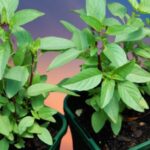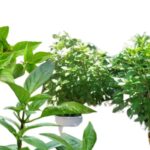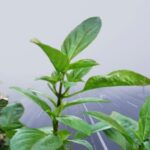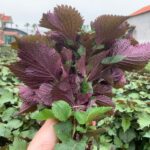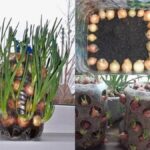Basil is a herb with a strong aromatic scent and a spicy flavor. It can be consumed raw or used as a seasoning in various dishes. In addition, this plant is also effective at repelling mosquitoes and other insects due to its high content of essential oils.
Basil is fairly easy to cultivate. You can grow it in your garden or in pots and containers.
**Preparing the Soil for Basil**
It is recommended to mix clean soil with worm castings in a 7:3 ratio to enhance the soil’s nutrition and promote better plant growth.
Choose a pot or container with holes at the bottom for drainage to prevent waterlogging, which can cause root rot.

Basil is easy to grow in pots or containers placed on balconies or rooftops.
**Selecting Basil Seeds or Cuttings**
You can start basil from seeds or cuttings. Purchase seed packets from gardening stores or supermarkets.
Soak the seeds in warm water (around 40-50°C) by mixing two parts boiling water with three parts cold water in a bowl. Place the seeds in this mixture and let them soak in a dark place until they crack slightly.
If you don’t have time to soak the seeds, you can sow them directly into the soil, but this method will result in slower germination and uneven growth.
Alternatively, you can propagate basil through cuttings.
**Sowing Basil Seeds or Planting Cuttings**
Sow the seeds about 0.5 cm below the surface of the potting soil, spacing them about 20 cm apart to allow adequate room for growth. Water the seeds after sowing.
If using cuttings, select sturdy, healthy branches with green leaves and robust stems. Cut each cutting to a length of about 3-5 cm, remove the lower leaves, and insert the cutting about 3-4 cm into the soil. Lightly water the cuttings. In about 13-15 days, you will notice new shoots emerging.
Basil thrives in warm temperatures and grows fastest at 25-35°C. It can be grown during hot summers, but its growth will slow down or even wither when temperatures drop.
Ensure your basil plant receives 6-8 hours of sunlight daily.
**Caring for Your Basil Plant**
Basil prefers moist soil. During hot weather, you can cover the soil with leaves or a shade net to retain moisture. Water regularly, but pay attention to the soil’s moisture level to avoid overwatering, which can lead to root rot.
When the basil sprouting reaches 10-15 leaves, pinch out the central shoot to prevent early flowering and encourage bushier growth. If flowers do appear, remove them to prevent the plant from going to seed and dying back.
After about 15-20 days of growth, you can add a small amount of worm castings to the soil to provide additional nutrients and promote faster growth.
**Harvesting Basil**
You can start harvesting basil once the plant reaches a height of 15-20 cm. Simply pluck the leaves as needed, and the plant will continue to produce new branches. The more you harvest, the more new leaves the plant will grow.
You can cut back the plant by two-thirds, leaving about 5 cm of growth above the soil, and then continue caring for it and providing fertilizer. After about 20 days, the plant will regrow, and you can harvest again.
After two harvests, you can apply oilseed cake fertilizer or other organic fertilizers.
However, as the weather cools down, it’s best to harvest basil early to prevent wilting. You can leave a few plants to flower and produce seeds for the next growing season. If you notice a decrease in productivity after multiple harvests, consider uprooting the plants and starting over.
“Grow Green Onions with These Two Easy Methods for a Year-Round Supply”
Growing green onions is a simple and easy task, and you can easily do it at home. All you need are some onion roots, and you can grow them in water (hydroponically) or in soil, using plastic bottles. This way, you not only get to enjoy fresh, clean greens but also have a beautiful, edible decoration in your home.

























